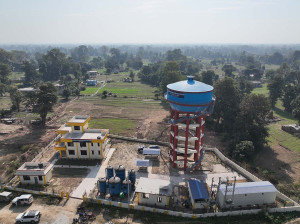Money
17 diners receive 'very good' rating after food hygiene inspections
Government teams checked 501 roadside restaurants and eateries in the last fiscal year for food quality and hygiene.Krishana Prasain
Only 17 among the 501 diners on Nepal's highways passed food hygiene inspections with a 'very good' rating, according to a report issued recently by the Department of Food Technology and Quality Control. These establishments were awarded a green sticker with three stars.
Matina Joshi Vaidya, director general of the department, said it was very challenging to be graded 'very good', and many among the 501 roadside restaurants and eateries the department checked in the last fiscal year for food quality and hygiene did not meet the required standards.
“It is not enough to have good food hygiene, you need to have a consistent record of maintaining proper hygiene which many restaurants did not have,” she said.
The restaurants and eateries may be maintaining quality, but they should also keep records to show the inspection team that they offer quality and standard foods, she said.
The inspection team cannot check the restaurants daily, so the team normally grades them based on their records, she said. “Restaurants and eateries must be able to show how they are assuring quality and safety when the inspection team asks for it,” she told the Post.
Maintaining quality and hygiene is a basic requirement. There are other criteria like maintaining the proper temperature in the refrigerator, ensuring that cooked food is kept at a temperature of at least 75 degrees Celsius, washing salad ingredients in potassium permanganate or chlorine, and not reusing cooking oil.
Hotels and restaurants also need to keep health records of their employees as per the hotel and restaurant analysis criteria.
According to the report, 82 hotels and restaurants, or 16.5 percent of the total, were graded 'good' and received a green sticker with two stars; 201 establishments, or 40 percent, were rated ‘satisfactory’ and were given a green sticker with one star.
The remaining 201 diners got a starless yellow sticker, meaning they needed improvement.
As per the department, restaurants classified as ‘very good’ will receive a green sticker with three stars, and restaurants ranked as ‘good’ will get a green sticker with two stars. A green sticker with one star means ‘medium’, and an eatery with a yellow sticker means it is in need of improvement.
The department in the previous fiscal year 2018-19 conducted inspections and standardisation in 860 hotels and restaurants. A total of 748 hotels and restaurants were categorised on the basis of food safety. Among them 14 were issued a very good score, 94 good, 288 satisfactory and 352 average.
Many hotels and restaurants in the previous fiscal year fell under the average category that needed improvement. According to the data, many diners were found to be not fulfilling standardisation requirements.
Mohan Krishna Maharjan, spokesperson for the department, said that ratings were issued particularly to hotels and restaurants on the highways where public vehicle movement is high. Inspection and standardisation were conducted in establishments that serve meals, he said.
Eateries in Khurkot, Nepalthok, Muglin, Malekhu and other highway rest areas were targeted because of their heavy traffic and long duration stops, he added.
“We began issuing ratings to the hotels and restaurants in places like Nagarkot and Bandipur with the start of Visit Nepal 2020, but we stopped inspecting them following the cancellation of the tourism promotional campaign,” he said.
The department's regional offices in Biratnagar, Janakpur, Hetauda, Bhairahawa, Nepalgunj and Dhangadhi inspected the diners and graded them, Maharjan said.
“The department's inspection teams look closely at kitchen hygiene, store, toilet sanitation, hygiene management, raw material store and hygiene knowledge,” Maharjan said.
In October 2017, the department issued a directive making it mandatory for hotels and restaurants to maintain food quality standards, food safety measures and hygiene.
Eateries have been classified into four types—very good, good, medium and average—based on the quality of food, service and infrastructure. The directive came into force after being endorsed by the Ministry of Agriculture Development.
Hotels and restaurants receive four types of stickers depending on how well they fulfil the standards prescribed by Good Manufacturing Practice, Good Hygiene Practice and Hazard Analysis Critical Control Point principles to protect consumers’ health.
The department received 461 complaints regarding processed drinking water, edible oil, quality of meat-related products, hotels and restaurants and the quality of rice, and its rapid response team took immediate action, officials said.




 11.74°C Kathmandu
11.74°C Kathmandu













